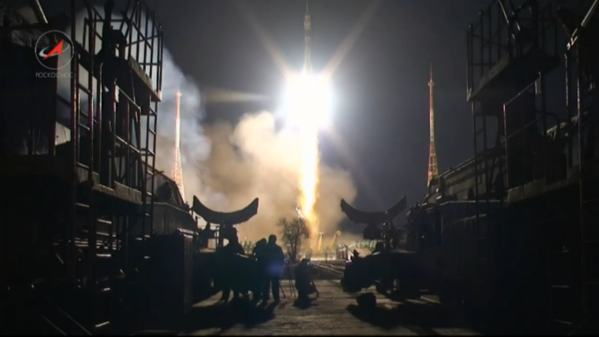
Three new crew members, representing three discrete sovereign countries and three national space agencies, are heading toward a docking with the International Space Station (ISS), following the successful launch of Soyuz TMA-15M from Site 31/6 at the Baikonur Cosmodrome in Kazakhstan. Russian cosmonaut Anton Shkaplerov, U.S. astronaut Terry Virts, and Italy’s first woman in space, Samantha Cristoforetti, roared into the night at 3:01:14 a.m. local time Monday, 24 November (4:01:14 p.m. EST Sunday, 23 November), and at the time of writing are in the process of executing four thruster “burns” to position themselves for a docking at the station’s Earth-facing (or “nadir”) Rassvet module at about 9:53 p.m. EST Sunday, a little under six hours and four orbits after liftoff. The trio will form the second half of the incumbent Expedition 42 crew, joining U.S. astronaut Barry “Butch” Wilmore and Russian cosmonauts Aleksandr Samokutyayev and Yelena Serova, who have been aboard the ISS since 25 September.
In readiness for their middle-of-the-night launch, the prime crew and their backups—Russian cosmonaut Oleg Kononenko, U.S. astronaut Kjell Lindgren, and Japan’s Kimiya Yui—were awakened about 8.5 hours before T-0. The final night’s sleep on Earth had been a strange one, according to Cristoforetti, in her last logbook entry. Although she admitted that it was “kind of cool” to write “Sorry, I’m off the planet for a while” for her email out-of-office replies, the forthcoming event was too enormous to wholly play down with humor. “The nap has been weird,” she wrote. “Part of my brain was dreaming, part of it was wide awake, watching myself dream. But that’s how the past few days have been: part of me was living all the events, meetings, traditions, of the past days, and part of me was almost watching a movie unfolding.” It only remained, she concluded, to thank her family, friends, teachers, and colleagues for bringing her from a space-loving girl in northern Italy to the Baikonur Cosmodrome, about to be launched into space. “I go to space with all of myself,” she said, rather poetically, “with everything that I am and I have experience and I certainly take with me every person I have met.”
Joining the Soyuz TMA-15M crew to gain experience of this period of quarantine was Danish astronaut Andreas Mogensen, who was assigned last year to a short-duration ISS mission, planned for late 2015. Terry Virts kicked off the day’s tweets, noting at shortly after 5 p.m. local time (6 a.m. EST) Sunday that his final medical checks had begun and adding that he was “putting the final touches on packing … a great way to simplify your life!” Next came the process of showering, which Cristoforetti described as “probably my longest shower ever,” as she paid tribute to “Good Russian wisdom to leave plenty of time for it on the schedule.” They were disinfected and microbial samples were taken in support of the medical experiments to be conducted in orbit. The crew’s final meal of home-made shepherd’s pie was proudly tweeted by Cristoforetti, whilst Virts described the taste as “awesome” and wistfully remarked that “I’m going to miss these things.”
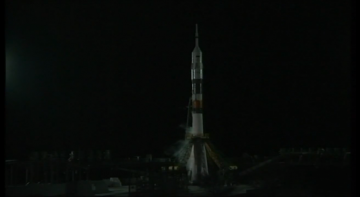
Their final Earthly meal was followed by the traditional blessing by a Russian Orthodox priest and departure from Baikonur’s Cosmonaut Hotel, shortly after 9 p.m. local time (10 a.m. EST), heading by bus to Site 254 to don their Sokol (“Falcon”) launch and entry suits. Cristoforetti expressed her heartfelt thanks to her supporters for their enthusiasm, but closing with a brisk “Time to go. Talk to you from space.” As the three prime crew members emerged from the hotel, the crowd of well-wishers included several current and former spacefarers. “Lots of family and friends there to cheer them on,” tweeted former astronaut and current Executive Director of the American Institute of Aeronautics and Astronautics (AIAA) Sandy Magnus. “All were smiling!”
At Site 254, the crew was able to speak, face to face, with members of their families, an occasion punctuated by a moment of poignancy when Anton Shkaplerov and his eight-year-old daughter, Kira, pressed the palms of their hands onto opposite sides of the glass screen in a final farewell. It served as a stark reminder of the inherent danger of the mission upon which the Soyuz TMA-15M crew were about to embark. Despite her tender age, Kira has also played another vital role in tonight’s flight to orbit, by providing the inspiration for the “gravity indicator” which will inform the Shkaplerov, Virts, and Cristoforetti of the onset of weightlessness. She suggested a fluffy toy of the snowman Olaf, from the 2013 Disney animated film, “Frozen.” Traditionally, a doll or mascot of some form is hung from a cord in the Soyuz descent module and when it begins to float it marks the crew’s entrance into the peculiar microgravity environment. Such gravity indicators on previous missions have included a toy giraffe on Soyuz TMA-13M in May 2014, courtesy of U.S. astronaut Reid Wiseman’s daughter, and a toy duck (nicknamed “Quack”) on Soyuz TMA-12M in March 2014, provided by the daughter of Russian cosmonaut Aleksandr Skvortsov.
Astronauts past and present wished the crew well, with former shuttle flyer Tom Jones offering “Godspeed” to his fellow Maryland native Virts, as British astronaut Tim Peake—who is currently training for the six-month “Principia” expedition, funded by the European Space Agency (ESA) and scheduled to begin in November 2015—tweeted “Godspeed, good luck & Go Shenanigans!” The Shenanigans is the group nickname applied to the six-strong ESA class of astronauts, selected in May 2009, to which both Peake and Cristoforetti belong. Veteran long-duration ISS resident Karen Nyberg added “Enjoy the ride!”, whilst recently returned German astronaut (and fellow Shenanigan) Alexander Gerst tweeted that the violent ascent to orbit would be “a bumpy ride, but well worth it.” Another member of the Shenanigans, French astronaut Thomas Pesquet, is currently training to begin his own six-month mission in November 2016. “We will be watching,” he told the crew, “and you’ll be taking a part of us with you!”
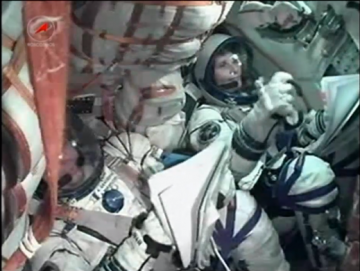
At 11:30 p.m. local time (12:30 p.m. EST) Sunday, Terry Virts tweeted a “selfie” from the bus, as he, Shkaplerov and Cristoforetti departed Site 254, bound for their waiting Soyuz-FG booster at Site 31/6. This marked the first occasion since Soyuz TMA-06M in October 2012 that this particular pad has been employed for a piloted launch; most ISS-bound Soyuz missions are lofted from Site 1/5, but this complex is presently undergoing a lengthy period of modification. Reaching the pad within the hour, the crew ascended the steps to the vehicle and were ensconced into their specially contoured seats aboard the bell-shaped Soyuz TMA-15M descent module. Cristoforetti assumed the Flight Engineer-1 position on the left side of the cabin, with Virts taking the Flight Engineer-2 seat on the right. At length, they were joined by Shkaplerov, who occupied the central commander’s couch. Bob Behnken, the chief of NASA’s astronaut office, tweeted at 12:40 a.m. local time Monday (1:40 p.m. EST Sunday) that all three crew members had boarded the spacecraft and hatches were sealed an hour later. Soyuz TMA-15M will deliver them to and from low-Earth orbit and will serve as their emergency return vehicle for the next six months.
As described in AmericaSpace’s Soyuz TMA-15M preview article and crew profiles, this mission marks the second space voyage for both Shkaplerov and Virts. The former previously served aboard Expedition 29/30 in November 2011-April 2012, during which he accrued more than 165 days in orbit and one spacewalk, whilst the latter flew as pilot of shuttle Endeavour during the 13-day STS-130 mission in February 2010, which featured the delivery and installation of the Tranquility node and multi-windowed cupola at the ISS. By complete contrast, Soyuz TMA-15M will be the first flight of Cristoforetti, making her the 538th human space voyager, the 59th female spacefarer, and Italy’s first woman in space. Preceded by representatives of Russia, the United States, the United Kingdom, Canada, Japan, France, Iran, and China, her flight also marks out Italy as the ninth discrete sovereign nation to boast its own female astronaut.
Whilst the three crew members assumed their positions, final checks were underway on the giant Soyuz-FG booster, which is a direct descendent of Chief Designer Sergei Korolev’s R-7 missile. An early version of this behemoth carried Yuri Gagarin into space in April 1961. Fueled with a mixture of liquid oxygen and a highly refined form of rocket-grade kerosene, known as “RP-1,” the Soyuz-FG is powered off the pad by the single RD-108 engine of its core stage and the RD-107 engines of its four tapering, strap-on boosters. After the oxygen had been fully loaded, by 1:00 a.m. local time Monday (2:00 p.m. EST Sunday), it entered a “topping” mode, whereby all cryogenic boil-off was replenished until close to T-0, in order to ensure that the tanks remained at “Flight Ready” levels, ahead of engine ignition. Weather conditions at Baikonur were described as “bone-chilling” by NASA’s Rob Navias, with a slight possibility of snow and a temperature of only a little higher than -8 degrees Celsius (18 degrees Fahrenheit).
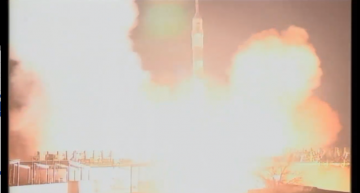
In the final 15 minutes, the Launch Abort System (LAS) was armed and transferred to Automatic Mode. Shkaplerov, Virts, and Cristoforetti were instructed to close their visors and the commander’s cockpit displays and instruments were activated. Internal avionics were initiated and the spacecraft’s on-board flight recorders were spooled-up to monitor the myriad systems during ascent. Inside the control bunker, the “launch key”—an actual, physical key—was inserted in order to enable the ordnance to send the Soyuz-FG on its mission. This was followed by the completion of nitrogen purging, the pressurization of the rocket’s propellant tanks and the continued topping of cryogens. Approximately 150 seconds before T-0, the star-like ISS itself passed directly above Baikonur.
A minute prior to liftoff, the Soyuz-FG systems transferred to internal power, and at T-10 seconds the engine turbopumps attained full speed. By five seconds, the engines of the core and tapering boosters roared to life and quickly reached full power. This produced a retraction of the fueling tower and a liftoff into the darkened Baikonur sky at 3:01:14 a.m. local time Monday, 24 November (4:01:14 p.m. EST Sunday, 23 November). Rising rapidly, the rocket exceeded 1,100 mph (1,770 km/h), within a minute of clearing the tower, and at T+118 seconds the tapering boosters were jettisoned, leaving the core stage alone to continue the boost into low-Earth orbit. By the two-minute mark, Shkaplerov, Virts, and a broadly smiling Cristoforetti had surpassed 3,350 mph (5,390 km/h) and, shortly thereafter, the escape tower and launch shroud separated, exposing the Soyuz TMA-15M spacecraft to the near-vacuum of the rarefied high atmosphere. Terry Virts could be seen offering a thumbs-up to his terrestrial audience in one of the in-cabin views at this time.
Four minutes and 47 seconds after leaving the desolate steppe of Central Asia, the core booster was jettisoned at an altitude of 105.6 statute miles (170 km) and the third and final stage ignited, accelerating the Soyuz stack to a velocity of more than 13,420 mph (21,600 km/h). The only minor issue which cropped up was “a slight G-load and shaking,” although this was reportedly considered “normal.” By the time the third stage separated, just less than nine minutes into the flight, the crew entered an orbit of about 125 x 160 miles (200 x 260 km), inclined 51.6 degrees to the equator, and began the process of deploying their craft’s communications and navigation antennas and electricity-generating solar arrays. This deployment process was reportedly complete shortly after 4:12 p.m. EST Sunday.
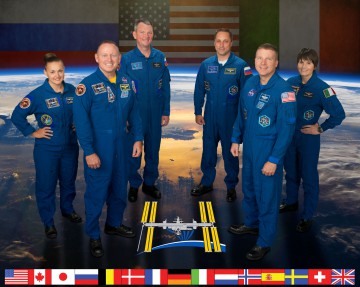
Four maneuvering “burns” will be required to raise the apogee of this orbit to reach the operational altitude of the ISS. The first burn (DV-1) should occur 45 minutes into the mission, after which a second burn (DV-2) is timed at 90 minutes after liftoff. These will be followed by another pair of burns, later in the rendezvous sequence, which should position Soyuz TMA-15M for docking at the space station’s Earth-facing (or “nadir”) Rassvet module at 9:53 p.m. EST Sunday, about five hours and 52 minutes into the flight. Should anything go awry to prevent any of the steps of the “fast rendezvous” from taking place—such as the software glitch which blighted the early stages of Soyuz TMA-12M in March 2014—the mission will revert to a “default,” two-day approach profile. This would produce a docking at Rassvet on the evening of Tuesday, 25 November.
Following standard pressure and leak checks, the hatches will be opened and the trio will be greeted by the incumbent Expedition 42 crew of Commander Barry “Butch” Wilmore and his crewmates, Aleksandr Samokutyayev and Yelena Serova. At the time of the Soyuz TMA-15M docking, the ISS will also accommodate two unpiloted visiting craft: Russia’s Progress M-25M and Europe’s fifth and final Automated Transfer Vehicle (ATV-5). The six crew members will work together until mid-March 2015, whereupon Wilmore, Samokutyayev, and Serova will return to Earth and Virts will take command of the ISS to inaugurate Expedition 43. His crew will be augmented back up to a full six-person strength later that month, when Soyuz TMA-16M launches to orbit with Russian cosmonauts Gennadi Padalka and Mikhail Kornienko and U.S. astronaut Scott Kelly.
Want to keep up-to-date with all things space? Be sure to “Like” AmericaSpace on Facebook and follow us on Twitter: @AmericaSpace
Missions » ISS » Soyuz TMA-M » Missions » ISS » Soyuz TMA-M » TMA-15M »



One Comment
One Ping
Pingback:Cristoforetti Set for Endurance Record, as Expedition 43 Return Reportedly Delayed to Mid-June « AmericaSpace